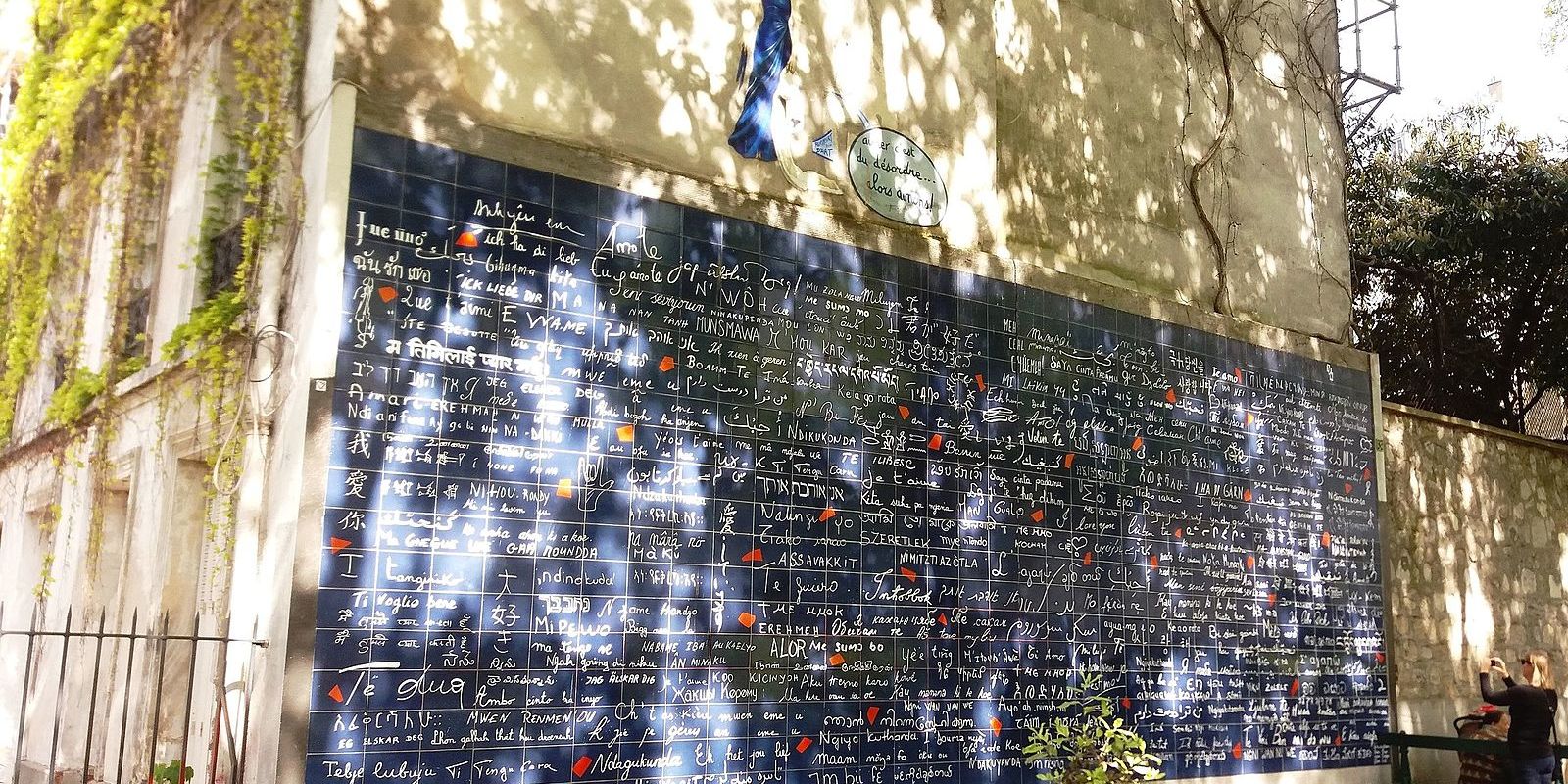Itinerary
Paris is full of romantic places for a declaration, a date or a lovers walk. From Montmartre to the left bank of the river Seine, here’s what the city has the best to offer to both would-be and established couples !

If you want to have a really loved-up getaway, this is for you. You’ll get to undestand or simply realize again why Paris is said to be one of the most romantic city in the World.
This itinerary is not at all meant to be comprehensive, but will nevertheless be rich and fulfilling, we hope. Yes, we didn’t include the obviously very romantic Eiffel Tower, but see that as an opportunity for yet another getaway with your lover, some other day. And yes, we chose to avoid the almost worn-out (but still enjoyable, we admit) “bateau-mouche” cruise on the Seine.
Rather, we’d like to let you wander freely among those charming and varied places, with only love in your mind. From the Montmartre hill to the banks of the Seine, let’s follow this itinerary at your own pace.
Just have at least 3 hours before you to do everything. Of course you’ll have breaks that may lenghten this duration, but that’s fine. With the exception of the Museum of Romantic Life, you won’t need tickets for the places we included here, so you can easily make changes to the itinerary as you please.
On you lover’s way to Paris, then !
10 stops
1. Montmartre Hill
Montmartre hill, primarily known for the white-domed Basilica of the Sacré Cœur on its summit, as well as for the artists in the Place du Tertre, is one of the most popular tourist area in Paris. A funicular railway, the Funiculaire de Montmartre, ascends the hill from the south.
The toponym Mons Martis (“Mount of Mars” in Latin) survived into Merovingian times, Christianised as Montmartre, signifying “mountain of the martyr”.
The area developed into a centre of free-wheeling and decadent entertainment at the end of the XIXth and the beginning of the XXth centuries, and it became the principal artistic center of Paris. Inpiduals including Vincent van Gogh, Henri Matisse, Pierre-Auguste Renoir, Edgar Degas, Maurice Utrillo, Henri de Toulouse-Lautrec, or African-American expatriates such as Langston Hughes worked in Montmartre and drew some of their inspiration from the area.
Montmartre Hill main sights also include the Marché Saint-Pierre, area of the cloth sellers in the south-east ; concert halls (La Cigale, L’Elysée-Montmartre, Le Trianon, La Boule Noire, the Moulin de la Galette…) inspired from the 19th century cabarets ; the Montmartre cemetery ; or the famous and often sung rue Lepic with its Les Deux Moulins café, made famous around the world by Le Fabuleux Destin d’Amélie Poulain movie.
The Fête des vendanges of Montmartre, which assembles more than 500,000 people during the first October weekend, every year.
Source : Wikipedia contributors, “Montmartre“
2. Square Jehan-Rictus
Located at the Place des Abbesses, this garden is a perfect romantic spot : cherry trees and other fruit-trees, roses, a pergola and a fountain…
No wonder then that is has been chosen by artists Frédéric Barton and Claire Kito (the latter being specialized in far-eastern calligraphy) for their “Mur des je t’aime” (“I Love You : The Wall”), a “monument dedicated to love”.
On 612 enamelled lava tiles are inscribed the words “I love you” 311 times in different languages (including the 192 languages of the UN Member States).
3. Museum of Romantic Life
The Musée de la Vie romantique (The Museum of Romantic Life, or Museum of Romantics) stands at the foot of Montmartre hill in the IXe arrondissement, in a 1830 hôtel particulier facing two twin-studios, a greenhouse, a small garden, and a paved courtyard.
The main pavilion, built in 1830, was the Paris base of the Dutch-born painter Ary Scheffer (1795–1858), one of the prominent artists of the time, close to King Louis-Philippe and his family. For decades, Scheffer and his daughter hosted Friday-evening salons, among the most famous in La Nouvelle Athènes. George Sand (1804–1876) used to come as a neighbour with Frédéric Chopin, meeting Eugène Delacroix, Jean Auguste Dominique Ingres, Alphonse de Lamartine, Franz Liszt, Gioacchino Rossini and singer Pauline Viardot. Later in the century, Charles Dickens, Ivan Turgueniev, and Charles Gounod attended regularly.
The property remained by descent in private hands till 1982 when it became a museum, under the name of “Musée Renan-Scheffer”. It is now one of the City of Paris’ three literary museums, along with the Maison de Balzac and the Maison de Victor Hugo.
After an extensive renovation conducted by Jacques Garcia under the direction of Anne-Marie de Brem, it reopened in 1987 as “Musée de la Vie romantique”. The Museum displays on the first floor numerous mementos of most notorious romantic character and writer George Sand, including family portraits, household possessions, pieces of jewelry and memorabilia among which plaster casts by Clésinger of the writer’s sensuous right arm and Chopin’s delicate left hand, plus a number of her own unique and rare watercolours called “dendrites”.
On the second floor, one can admire a number of Romantic canvases, sculptures and objets d’art. The Museum also displays several portraits and material related to the famous scholar and writer Ernest Renan who had married Ary Scheffer’s niece.
Source : Wikipedia Contributors, “Musée de la vie romantique”
4. Passage Jouffroy
This covered pedestrian walkway runs between the Boulevard Montmartre to the south and de la Grange-Batelière street to the north. It is about 140 metres (460 ft) long and 4 metres (13 ft) wide. About 80 metres (260 ft) from its entrance on the Boulevard Montmartre, the passage makes a right angle turn and runs west for a few metres before descending some stairs.
The passage is covered by a canopy of metal and glass. An ornate clock stucco overlooks the alley.The exit from the musée Grévin is located inside the Passage Jouffroy.
It was was built in 1845, along the line of the Passage des Panoramas in order to capitalize on the popularity of the latter, by architects François Destailleur and Romain de Bourges. The Passage Jouffroy represents an important stage in the technological evolution of the 19th century and the mastery of iron structures. It is the first Parisian passage built entirely of metal and glass. Only the decorative elements are wooden. It is also the first passage heated by the ground.
The museum includes a hall of mirrors that was originally housed in the Palais des mirages designed by Eugène Hénard for the Exposition Universelle (1900).
In 1974 the passage was registered as a French historical monument. The passage was completely renovated in 1987 and regained its original paving.
Source : Wikipedia contributors, “Passage Jouffroy”
5. Palais-Royal Garden
The Garden as well as the entire Palais-Royal complex is an exquisite place situated just north of The Louvre Palace, west of the Bank of France and right near the Comédie-Française (France prestigious state theater) and the Louvre des Antiquaires (a group of 250 antiques and jewellery shops).
If entering the garden by the north (from Vivienne or des Petits-Champs streets), you’ll probably exit at the controversial Buren’s columns (1986, restored in 2009 ; the installation actual name is “Les Deux Plateaux”). You’ll then find the Saint-Honoré street and the Square of the Palais-Royal, from where you can see the Cour de l’horloge.
The Palais-Royal now houses the Conseil d’Etat (whose entrance is situated Cour de l’horloge), the Constitutional Council and the Ministry of Culture.
6. Cour Carrée of the Louvre
There are many small details which can make your visit of the beautiful Cour carrée all the more entertaining.
At the center, sit on the fountain to enjoy the view. On each wing, you’ll find monograms (the initials of the kings – along with their wives – under whom the particular wing had been build).
On the ground, some metal gates and a contour still visible on the cobblestones is all that’s left of Charles V’s old donjon.
On the east wing, a cock statue can be found inside an ouroboros (a snake that bits its tail).
And of course there are the “Legislateurs”, 4 statues made in 1806 by Jean-Guillaume Moitte. Go and see the one of Manco-Cápac in particular, the first emperor of the Incas.
7. Vert-Galant public garden
This lovely small public garden at the west end of the Île de la Cité has a very nice view of the Louvre Palace, the Hôtel de la Monnaie and the cupola of the Institut. You can observe chestnut trees and swans.
A famous 1950 Robert Doisneau photography features the Vert-Galant garden.
On March 18, 1314, Jacques de Molay, the last Grand Master of the Knights Templar, was burned alive in the small patch of land that is now the Vert-Galant garden. A commemorative plaque has been attached to a wall nearby by freemasons. Will you be able to find it ?
8. Pont des Arts
Between 1802 and 1804, under the reign of Napoleon I, a nine-arch metallic bridge for pedestrians was constructed at the location of the present day Pont des Arts (or Passerelle des Arts) : this was the first metal bridge in Paris. The engineers Louis-Alexandre de Cessart and Jacques Dillon initially conceived of a bridge which would resemble a suspended garden, with trees, banks of flowers, and benches.
The bridge would be closed to circulation in 1977 and, in 1979, suffered a 60 metre collapse after a barge rammed into it. The present bridge was built between 1981 and 1984, identically, according to the plans of Louis Arretche, who had decided to reduce the number of arches from nine to seven, allowing the look of the old bridge to be preserved while realigning the new structure with the Pont Neuf.
The bridge has sometimes served as a place for art exhibitions, and is today a studio en plein air for painters, artists and photographers who are drawn to its unique point of view. The Pont des Arts is also frequently a spot for picnics during the summer.
In recent years, many tourist couples have taken to attaching padlocks with their first names written or engraved on it to the railing or the grate on the side of the bridge, then throwing the key into the Seine river below, as a romantic gesture. This gesture is said to represent a couple’s committed love. The City of Paris has not yet adopted a definitive policy on how to deal with this new fad. The French police have been known to patrol this bridge to stop keys from being thrown into the river.
Source : Wikipedia contributors, “Pont des Arts”
9. Place de Furstemberg
Located in Saint-Germain-des-Prés, de Furstemberg (or Furstenberg) street is indeed actually a street and not a square, although it’s often refered as such, because of its central part’s shape.
Calm and full of charm, the street is claimed to be one of the most expensive in Paris in terms of real estate. Several artists worked here, a number 6, among them Eugène Delacroix. The National Museum bearing the name of the famous painter is located exactly there nowadays.
10. Square René-Viviani
The Square René-Viviani – Montebello, created in 1928, is located north and around Saint-Julien-le-Pauvre church, opposite Notre-Dame. It is named after the French lawyer and politician René Viviani, (who was responsible for introducing the income tax in France, and who died in 1925), and after the nearby Montebello embankment.
What’s specific about this square is the black locust (Robinia pseudoacacia) planted in 1601 by botanist Jean Robin who introduced the species in France. This tree is thought to be the oldest of Paris.
Source : translated from Wikipedia contributors, “Square René-Viviani – Montebello“
Map, navigation, practical information, extra pictures and more are available on the Paris Parcours app.
